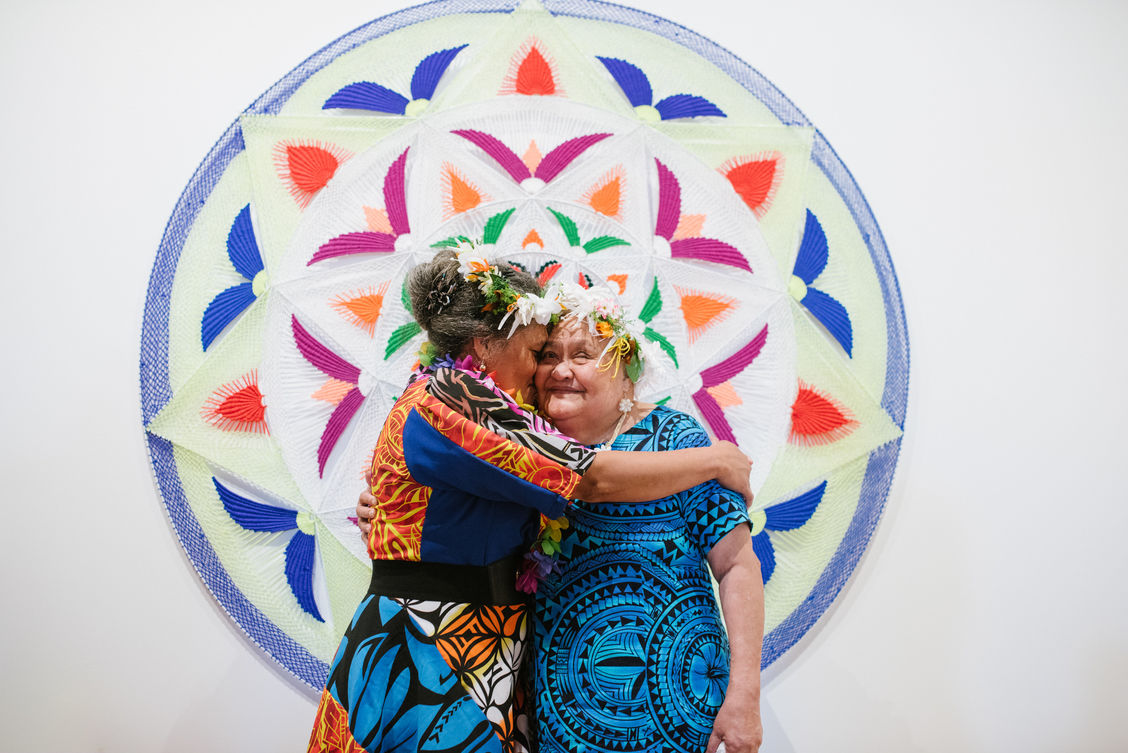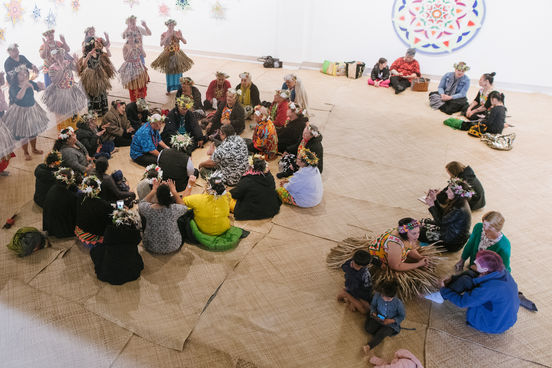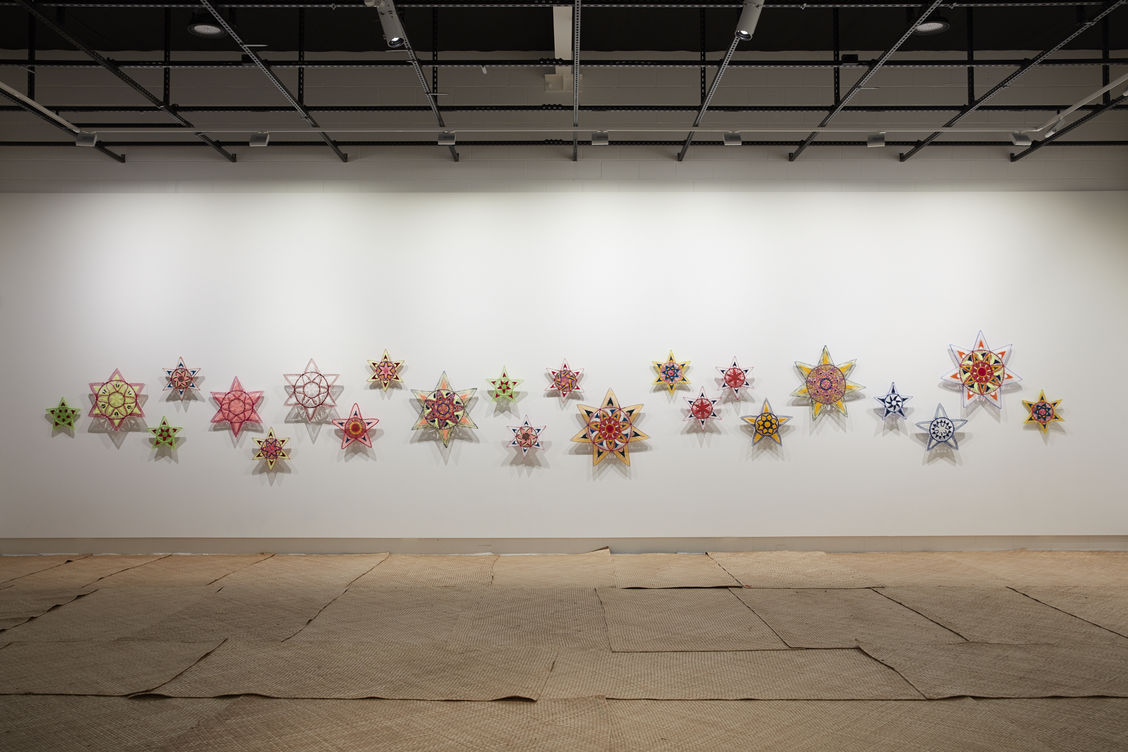-
Author
Madeleine Chapman -
Date
11 Oct 2018
Essay
The Single Object
Weaving a life: Lakiloko and the functional beauty of Tuvalu art
Like a lot of artists, Lakiloko Keakea creates her masterpieces in a dressing gown. She has a few, but on the day I visit she’s wearing pink. Pink dressing gown, slippers and the stamina to stand for the entirety of my ninety-minute visit. She stands because she’s working. A metal frame — alongside it for three weeks, working. Her hands are in constant motion, pulling a roll of blue yarn; wrapping it around the frame; stretching it between bars; tying what looks like knots throughout the space.
While Lakiloko is working, her granddaughters Loleta and Patricia translate my questions. Lakiloko doesn’t speak much, and only in Tuvaluan, but when she does, her hands never stop moving. Watching her is watching a master at work. The rhythm in her movements is soothing.
I tell Loleta that I am Tuvaluan — an obligatory disclaimer whenever you meet someone with a shared heritage – and she asks me what island I’m from. Ashamed, I say I don’t know. I’m Tuvaluan but have always known myself to be Samoan since my Tuvaluan ancestor — my grandfather — had moved to Samoa early and lived there his whole life. Mum had told me before but I’d never bothered to learn more or even remember the name of my grandfather’s birthplace. “What’s his name?” Loleta asks. I tell her and she shakes her head. “What about his father’s name?”
“Vailei,” I say.
“Vailei sounds like a Nanumea name.”
I recognise it as soon as she says it and know she’s right. I’m from Nanumea, and I tell her so.
“Grandpa’s from Nanumea so what’s the bet we’re probably related. If you’re hungry and you’re around here just come by.”
Lakiloko Keakea was born on the island of Nui in 1949 before Tuvalu was Tuvalu. Back then it was a part of the Gilbert and Ellice Islands until 1976 when the colony ceased to exist and the separate colonies of Kiribati and Tuvalu were formed. The culture of Tuvalu is greatly influenced by the cultures of the islands surrounding them. Even the language is a collaboration, if you will, of Samoan, Tongan, Tokelau, and Kiribati.
In 1957, Lakiloko moved to Niutao, where she soon learned the art of kolose, a transliteration of ‘crochet’. But while the technique stems from European crochet, it has been modified and elevated to be distinctly Tuvaluan. As Loleta says, “I’ve been around grandma’s crochet all my life and it doesn’t look like” — her voice drops to a whisper — “white people crochet.”
The art of kolose. Some — many — would call it a craft, or even traditional handicrafts. Kolose is an art form. It’s a distinction that feels pedantic but highlights the dismissal of Pacific art for decades. Writer Albert Wendt first addressed the issue in 1994, when advising Te Papa Tongarewa. He later elaborated to Te Papa’s senior curator – Pacific cultures Sean Mallon, saying “I came to feel very uncomfortable with terms such as traditional, folk history, folk art…Colonial scholars and researchers used them whenever they referred to us but not to their cultures. Traditional inferred our cultures were/are so tradition-bound they were static and slow to change; that they weren’t dynamic and growing and changing; that because they were slow to change and fixed in history they were ‘simple and easy to understand.’”
There’s a westernised approach to art that suggests the best art is only for observing. The most valuable pieces of art are never touched, let alone serve a practical purpose. In Tuvalu, as in all Pacific islands, art is made to be worn, used, sat on, lived in. The dual purpose of Pacific art as both a thing of beauty and a thing of purpose does not diminish its value, it elevates it.
The kolose, named for the technique, is a garment worn by Tuvaluan women. But while it’s a formal piece of clothing — filled with the brightest colours you can imagine – it’s not often worn on display. “Even though it’s so beautiful, we wear it on the inside of things, close to our skin,” says Loleta. “Which is really strange but that’s where we keep our art, close to our skin.”
Those who show a particular skill, whether in kolose or weaving the fine mats, have a responsibility to provide those things for the family and community. Lakiloko has always been the best at kolose, and as such, designed and made the unofficial uniform of the Fafine Niutao I Aotearoa (Women of Niutao in Aotearoa). Fafine Niutao I Aotearoa is a New Zealand-based arts collective, with around 100 members. A core group of elder members meet every Thursday at the Pacifica Arts Centre in Henderson. The gatherings are social but ask any child of a Polynesian woman and they’ll tell you there’s no such thing as social gatherings. If the women are gathering, work will be done.

Lakiloko Keakea: Fafetu, 2018. Image: Haru Sameshima.

Lakiloko’s husband disappears into a side room and reemerges with the kolose, placing it down next to me. At first glance it looks like the crochet I’ve seen throughout my life: thick wool woven together in large stitches. But on closer inspection I see that what I’d observed as a single strand of thick wool was, in fact, a dozen tiny pieces of thread woven and knotted together. This is what Loleta meant when she said her grandma’s kolose was different from white people crochet. The design is precise, down to single, barely visible, stitches. There’s shapes, lettering, and endless colours. I ask how she designs them and both her granddaughters shrug. “She just makes it up as she goes along,” says Patricia. So how does she know when to change colour or direction? “She counts.” I look down at the seemingly infinite number of stitches and suddenly feel tired.
There’s a repetitive nature to Pacific artforms that rewards persistence and patience. Abstract bursts of inspiration will only get you so far; your body must carry you the rest of the way. It’s no surprise that the women are the ones who create art daily. Patricia explains, with equal admiration and exasperation, that if it weren’t for her grandkids, Lakiloko would work until the project was finished, no matter how long it took. For the last two years, Lakiloko has been working on 40 fafetu for her first ever solo exhibition at the Auckland gallery Objectspace. The fafetu that Lakiloko is working on in her living room is the final work for the exhibition and is her biggest yet, perhaps the biggest ever. But even the biggest project is treated to the same approach.
“It’s been three weeks now,” says Patricia. “We have to remind her to eat, to take her pills, to have a shower, to sleep.” The description reminds me of my mum, who always insists on working “until it’s dark”, then turns on a flashlight and insists it’s still light. When I tell them this, Loleta nods knowingly. “That’s the Tuvalu in her.”
Lakiloko works on the fafetu for upwards of 12 hours a day, every day. She doesn’t listen to music, doesn’t have the TV on in the background, and doesn’t talk unless absolutely necessary. I ask her what she thinks about all day while her hands are working. “If you do something, make sure you do it and finish it. I just think about getting it done.”
As if on cue, her husband walks to the kitchen to make them both a hot drink. He pulls out, no exaggeration, the two biggest mugs I’ve ever seen and fills them with coffee. There must be at least three standard cups in each one. “She goes through about three of those a day,” says Patricia. “She’s a real artist,” adds Loleta, laughing. Lakiloko rethreads her needle.
For someone with vision in only one eye, Lakiloko has incredible depth perception. Every needle thread is precise and very rarely does she miss a stitch. But despite her perfectionism, she welcomes collaboration. Patricia did a little bit of work on one of the sections. Loleta tells how their grandpa tried to help by completing a tiny portion, only for Lakiloko to redo the whole thing because he’d done it wrong. Lakiloko might be the artist whose work is on display, but the usual practice is to collaborate within the Tuvalu community. Because the vast majority of works are made collectively for the benefit of the community members.
I meet the community at the Ranui Seagulls clubrooms. For one Saturday after the rugby league season is over but before the cricket season begins, lies Tuvalu. Not all nine islands of Tuvalu; on this particular Saturday, the descendants of just one, Niutao, have gathered for their annual reunion.
I stand out in the crowd. Everyone is in uniform, either yellow and green, or yellow and blue. I count myself lucky that I just happened to pick out a yellow lavalava to wear. Today’s festivities are a friendly competition between the two sides of the island, with sports, singing and dancing just a few of the events. But in the end there’s no real winner. The competition is simply something to do, an excuse to get together.
I’m here for this profile – gathering background on Lakiloko – but for my own selfish reasons too. I’m here on a Saturday because I’ve never experienced Tuvaluan culture before, a culture I’m very aware I’m a part of and yet have managed to, if not avoid completely, at least ignore for most of my life.
Here in the clubrooms, it’s impossible to ignore. No one speaks English. They can speak English, but the culture is so strong that even the teenagers speak Tuvaluan to each other. I suddenly feel very European. Marama T-Pole, promoter of Tuvalu art and facilitator for Lakiloko, acts as my translator. Being from the same community, Marama has been instrumental in getting Lakiloko’s work into public spaces and has subsequently shown the community another career path. “I wasn’t aware of what it would do for some of our young New Zealand-born Tuvaluans, seeing the work up there. I was more wanting to show the work to non-Tuvaluans so they could see what was happening within our communities.”
While this has certainly happened – groups of North Shore women visited their Takapuna exhibition and marvelled at the seamless crochet works – it’s helped the community deeper understand the beauty around them.
“There was a New Zealand-born Tuvaluan girl who came to the Mangere exhibition [in 2015] and just stood there looking up at the walls, amazed.
“I know it sounds awful but a lot of us never really appreciated the artwork around us until we saw them elevated within a mainstream context.”
I look down at the fine mat — lopa — we’re sitting on. It’s made with pandanus leaves and is purple and white, with flowers and vines weaved throughout. The next lopa over is red and yellow and covered in geometric designs. There’s a bag against the wall with kolose in it, and an older woman weaving next to it. In the middle of the room, the two sides are gathering to sing and dance. They’ve been practising for months and wear intricate costumes of kolose, fine mats, and headbands made with woven flowers. The drummers on each side form an inner-facing circle and start a beat. The singers gather closer as the tempo builds. When they sing, they sing not to an audience, but to each other.
And when I leave the gathering nearly three hours later, the community will still be singing; wearing their kolose; standing on their lopa; living through their art.
Madeleine Chapman has been a staff writer at The Spinoff since 2016. She is the co-author of My Life, My Fight, the Steven Adams autobiography, published in 2018.
The Single Object was developed in partnership by Objectspace and The Spinoff.

